7 best exercises to do if you sit down all-day
Yes, sitting down all day is bad for your health. Here's the workout to help.

You’ve probably already heard that sitting is the new smoking, but if your job requires you to sit behind a screen all day, what can you do to help alleviate the effects on your body?
Experts reckon that sitting more than three to four hours a day can increase a person's risk of serious diseases such as heart disease, cancer, and obesity, as well as cause posture problems and lead to muscle tightness. It can also lead to things like dead butt syndrome, where your glutes forget their role and stop supporting your back and pelvis.
So where’s the good news? As well as investing in a one of the best standing desks, or heading out for a walk on your lunch break, there is more you can do to help alleviate the effects of all that sitting. To help, we’ve rounded up some of the best exercises to add to your post-work routine.
The best exercises to do if you sit down all-day
As well as simply standing more during the day, exercises that focus on strengthening the posterior (or back) part of your body should be key in your workout routine. Your back, your glutes, and your hamstrings are all at risk of weakening or tightening if you spend too much time sitting down. You should also look at exercises that will stretch the anterior muscles along the front of your body — we’re talking about your hip flexors and your pelvis — as this can help counteract the tightness and help with your posture.
Here are the exercises to try:
1. Dead bugs
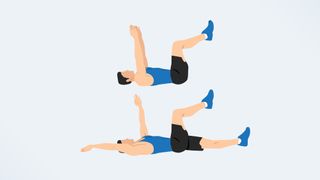
A dead bug works on stabilizing your core muscles, as well as your spine and back muscles - all important for good posture. Perform 20 of these, 10 reps on each side.
How to do a dead bug:
Sign up to get the BEST of Tom’s Guide direct to your inbox.
Upgrade your life with a daily dose of the biggest tech news, lifestyle hacks and our curated analysis. Be the first to know about cutting-edge gadgets and the hottest deals.
Start by lying on your back, keeping your lower back pressed into the mat — think about sucking your belly button into your spine. Raise your arms straight above you, and your knees into tabletop position. Slowly lower your right arm to a couple of inches off the floor behind your head, as you do so, stretch your left leg away from your body and lower that to just above the floor. Pause, then return to your starting position and repeat on the opposite side. Keep alternating sides, and aim for three sets of 10 reps on each side.
Read more on how to do a dead bug here, plus read what happened when our fitness editor did 100 dead bugs a day for a week.
2. Plank
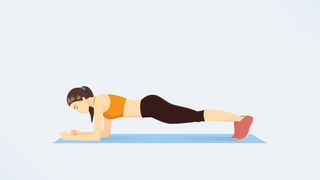
Although you might dread the plank section of your workout, they are a good way of working your core as well as your upper and lower body. A strong core has been shown to reduce lower back pain, which is often associated with prolonged sitting. Start by attempting to hold a plank position for 30 seconds, and gradually increase this to longer intervals as you get stronger.
How to do a plank: In order to correctly get into the plank position, start in a press-up position, with your arms slightly wider than your shoulders and your body weight resting on your hands flat against the floor, or your forearms, depending on which variation you opt for. Think about creating a straight line from your heels to the crown of your head, engaging your core.
Here's more on how to do a plank with correct form, the benefits, and the variations to try.
3. Glute bridge

The glutes are the biggest muscle in the body, and spending a prolonged period of time just sitting on them means they’re not being activated or worked at all. This, in turn, can make your hip flexor muscles tighter, causing compression in the lower back, which can lead to back pain.
To fire up your glutes, try practicing glute bridges. Aim to do 10-15 repetitions. If this feels too easy, or you really want to challenge yourself, try doing single-leg glute bridges instead.
How to do a glute bridge: To do a glute bridge with correct form, you’ll need to start by lying on your back on an exercise mat, with your feet pressed into the floor about hip-width apart. Engage your core (think about sucking your belly button into your spine) and squeeze your glutes together as you raise your hips and pelvis to the sky. Squeeze your glutes at the top, before slowly lowering your hips back to their starting position. That’s one rep. To make bodyweight glute bridges harder, raise your arms up to the sky.
Here's more on how to do a glute bridge with the correct form, plus what happened when this fitness editor did 50 glute bridges a day for a week.
4. Kettlebell squat
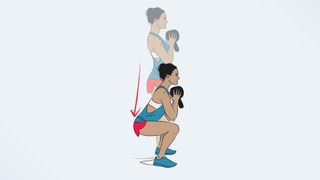
Another exercise that targets most of the muscles in your posterior, a kettlebell squat activates your hamstrings, glutes, calves, and lower back muscles, as well as your quads and your core. If you don’t have a kettlebell or a pair of dumbbells, try using something heavy, like a backpack filled with books, or milk cartons filled with water. Aim for 12 to 15 repetitions.
How to do a kettlebell squat: To do a kettlebell squat, start holding a kettlebell against your chest, with your feet shoulder-width apart. Pushing your hips back, lower into a squat position, keeping your core engaged. Push up from your feet to raise back into your starting position.
Here's 5 of the best kettlebell exercises for beginners to build muscle and strength
5. Lunge with a twist

A great one for anyone who sits down for a living, the lunge part of this exercise stretches the hip flexors, glutes, and adductors, while the rotation works on the thoracic spine. Aim to do 10-20 repetitions, with 5-10 on each side.
How to do a lunge with a twist: Watch a video on how to do a lunge with a twist correctly here.
6. Mountain climbers
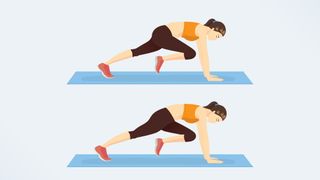
Mountain climbers target the shoulders, hamstrings, triceps, quads, and core — all areas of the body that are important for good posture. Aim to do 20 to 30 reps, with 10 to 15 on each side.
How to do a mountain climber: To do a mountain climber, start in a plank position, with your hands shoulder-width apart, your back flat, and your core engaged (think about sucking your belly button into your spine). From here, bend your left knee and bring it into your chest, as far as you can. Pause, then straighten your leg back to its starting position and bring your right knee in underneath your body. Keep repeating this movement and build up speed until you’re running your knees in and out.
Here's more on how to do a mountain climber with the correct form, plus read what happened when this fitness editor did 100 mountain climbers a day for a week.
7. Kettlebell deadlifts
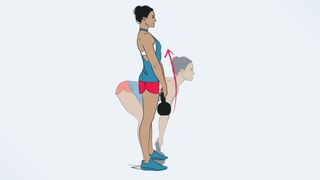
Deadlifts are another great way of targeting the muscles down the back of your body, as well as working on the core and hips. Again, if you don’t have a kettlebell for this exercise, try using some dumbbells, or anything you can find that’s easy to hold. If you’re traveling or don’t have anything to hand, bodyweight deadlifts are still are a great way to work on your posture. Aim to do 12 to 15 reps.
How to do a kettlebell deadlift: Stand with your feet shoulder-width apart, toes forward, and place the kettlebells on either side of your feet. Bend your knees and squat down to grip both kettlebells. Roll your shoulder blades back and down, engage your core, and squeeze your shoulder blades to engage your lats. Sit your bum down, chest forward facing, with a flat back. Look ahead and inhale. Exhale as you drive through your feet to stand, keeping the kettlebells close to your legs. Squeeze your glutes at the top and fully extend at your hips. Begin to lower the kettlebells with a soft bend in the knee, sending your hips backward with a flat back. At knee height, re-bend your knees and lower your bum to bring the kettlebells back down to the floor.
More from Tom's Guide

Jane McGuire is Tom's Guide's Fitness editor, which means she looks after everything fitness related - from running gear to yoga mats. An avid runner, Jane has tested and reviewed fitness products for the past five years, so knows what to look for when finding a good running watch or a pair of shorts with pockets big enough for your smartphone. When she's not pounding the pavements, you'll find Jane striding round the Surrey Hills, taking far too many photos of her puppy.
